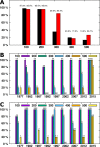Determining the utility of veterinary tissue archives for retrospective DNA analysis
- PMID: 27168995
- PMCID: PMC4860330
- DOI: 10.7717/peerj.1996
Determining the utility of veterinary tissue archives for retrospective DNA analysis
Abstract
Histopathology tissue archives can be an important source of specimens for retrospective studies, as these include samples covering a large number of diseases. In veterinary medicine, archives also contain samples from a large variety of species and may represent naturally-occurring models of human disease. The formalin-fixed, paraffin-embedded (FFPE) tissues comprising these archives are rich resources for retrospective molecular biology studies and pilot studies for biomarkers, as evidenced by a number of recent publications highlighting FFPE tissues as a resource for analysis of specific diseases. However, DNA extracted from FFPE specimens are modified and fragmented, making utilization challenging. The current study examines the utility of FFPE tissue samples from a veterinary diagnostic laboratory archive in five year intervals from 1977 to 2013, with 2015 as a control year, to determine how standard processing and storage conditions has affected their utility for future studies. There was a significant difference in our ability to obtain large amplicons from samples from 2015 than from the remaining years, as well as an inverse correlation between the age of the samples and product size obtainable. However, usable DNA samples were obtained in at least some of the samples from all years tested, despite variable storage, fixation, and processing conditions. This study will help make veterinary diagnostic laboratory archives more useful in future studies of human and veterinary disease.
Keywords: DNA extraction; Retrospective; Tissue archives.
Conflict of interest statement
The authors declare there are no competing interests.
Figures


References
-
- Dinno A. dunn.test: Dunn’s test of multiple comparisons using rank sums. R package version 1.3.1. 2015. Available at https://CRAN.R-project.org/package=dunn.test .
-
- Granato A, Giantin M, Ariani P, Carminato A, Baratto C, Zorzan E, Vascellari M, Bozzato E, Dacasto M, Mutinelli F. DNA and RNA isolation from canine oncologic formalin-fixed, paraffin-embedded tissues for downstream “-omic” analyses: possible or not? Journal of Veterinary Diagnostic Investigation: Official Publication of the American Association of Veterinary Laboratory Diagnosticians, Inc. 2014;26:117–124. doi: 10.1177/1040638713509378. - DOI - PubMed
LinkOut - more resources
Full Text Sources
Other Literature Sources

